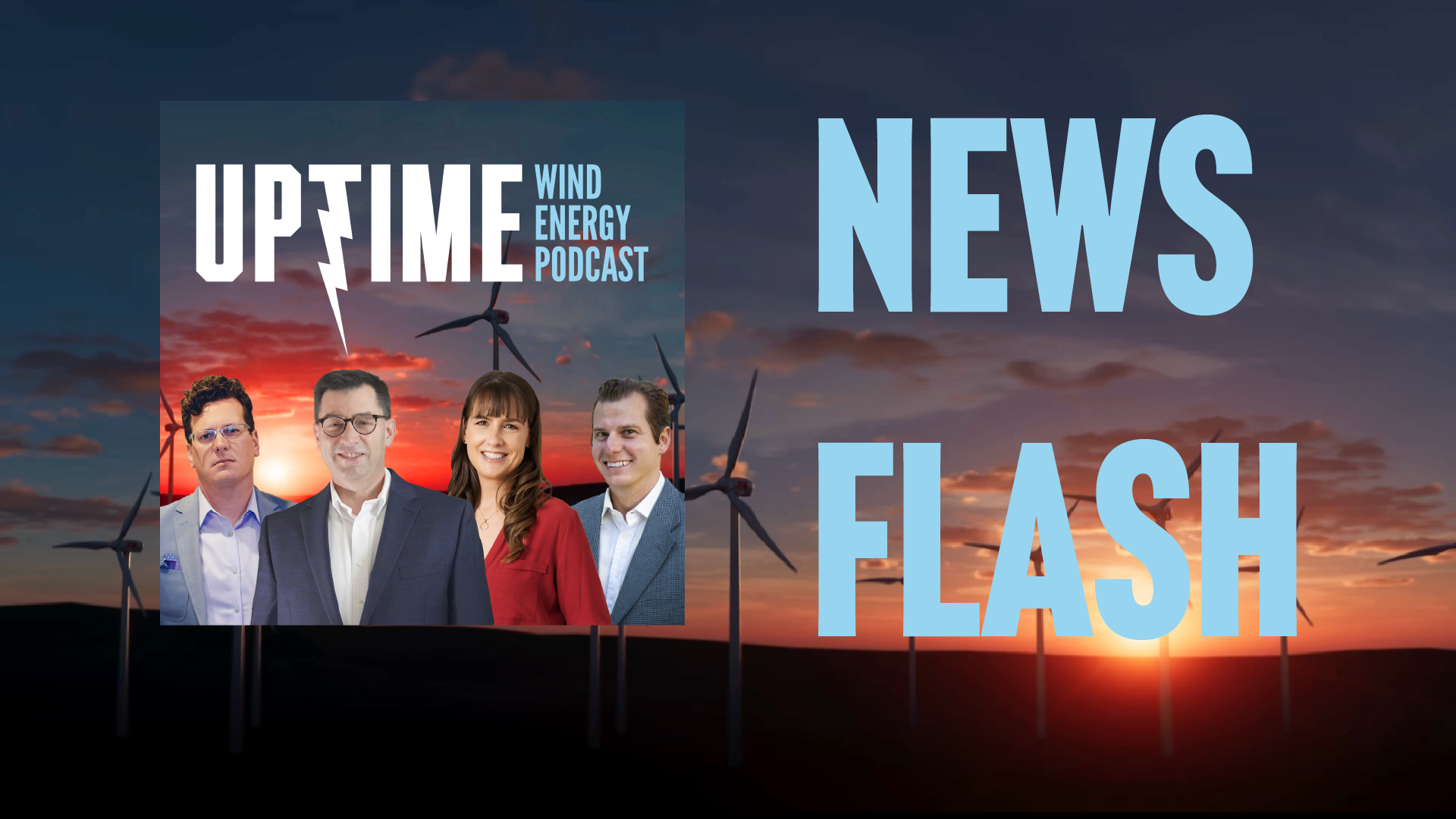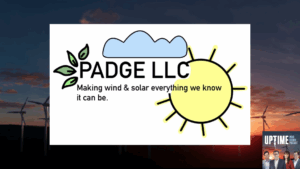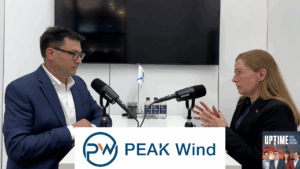Podcast: Play in new window | Download
Invenergy enters the Spanish offshore wind market with a planned 552 MW floating wind farm. Iberdrola considers selling US renewable assets to fund its Avangrid acquisition. Tata Power secures a major loan to finance clean energy projects in India, while National Grid divests US assets to focus on UK decarbonization.
Sign up now for Uptime Tech News, our weekly email update on all things wind technology. This episode is sponsored by Weather Guard Lightning Tech. Learn more about Weather Guard’s StrikeTape Wind Turbine LPS retrofit. Follow the show on Facebook, YouTube, Twitter, Linkedin and visit Weather Guard on the web. And subscribe to Rosemary Barnes’ YouTube channel here. Have a question we can answer on the show? Email us!
Pardalote Consulting – https://www.pardaloteconsulting.com
Weather Guard Lightning Tech – www.weatherguardwind.com
Intelstor – https://www.intelstor.com
Allen Hall: I’m Allen Hall, president of Weather Guard Lightning Tech, and I’m here with the founder and CEO of IntelStor, Phil Totaro, and the chief commercial officer of Weather Guard, Joel Saxum, and this is your NewsFlash. NewsFlash is brought to you by our friends at IntelStor. If you want market intelligence that generates revenue, then book a demonstration of IntelStor at intelstor.com.
Invenergy has announced its entry into the spanish offshore wind market with the proposed oh boy floating wind farm the planned capacity 552 megawatt site Is will be the furthest site away from the shoreline of spain if approved it will power over 600 thousand Spanish households. Wow, Phil the construction of the offshore floating wind farm is estimated to take between eight and ten years with Invenergy prioritizing local hiring and procurement through the project’s development.
So this is a really neat project by Invenergy, Phil.
Philip Totaro: Yeah, it’s interesting too, because the Spanish are trying to get an offshore market going. There’s, something like 40 plus gigawatts of projects that have been kind of tentatively proposed for different tenders that they’re supposed to have in Spain, but they haven’t actually gotten a framework in place for how any kind of You know, subsidies are going to work.
And I think power offtake may also still be a bit of a challenge there as far as the infrastructure needed to be able to support this much capacity. But the fact that, I mean, this is, and we’ve talked before about the fact that Invenergy is not exactly a U. S. company. They’re, it’s Canadian majority owned company as far as their, their parent investor, but let’s say they’re, the first occasion where I can recall a North American based company anyway, is venturing off into the European offshore wind market.
So this is pretty interesting and, and an exciting play for them.
Joel Saxum: One of the nice things here is that, that northwest corner of Spain. Good deep water port as well. So, the area’s gonna be primed and ready for it. There’s some demand locally there. They’re ready and willing to go here. 552 megawatts for a floating offshore wind farm. That’s again, I think last week we talked about the largest one we’ve heard of. This is now the largest one I’ve heard of. And the facilities are there, ready to go. Keyside to put these things out.
So, 8 to 10 years, I think we’ll see a big floating wind farm there.
Allen Hall: Spanish utility company Iberdrola is considering selling a 50 percent stake in a portfolio of U. S. renewable energy assets, which includes 400 megawatts of solar plants and 300 megawatts of onshore wind. For an estimated 1. 6 to 1. 8 billion us dollars.
The company is working with the bank of America on the potential sale and plans to formally launch the process in July with the aim of completing the transaction by the end of the year. This move comes as part of a broader review of Iberdrola’s strategy in the U S following its recent agreement to fully acquire its subsidiary of on grid for 2.
5, 5 billion. So, Phil, are they helping to fund the purchase of Avangrid with the sell off of a portion of Avangrid’s assets?
Philip Totaro: It sounds like it, yes. But keep in mind what we’ve also talked about is, first, they’re looking to deploy some capital in offshore, so it could be that they’re going to reuse some of this capital for that.
They’re also coming up at a point in time when, like we’ve talked about on the show before, they’re You know, at a point where they’re contemplating the repower on some of these assets as well. So part of this portfolio that they’re offering for sale could just be assets that are, the closest to the end of their PPA life.
Because again, as we’ve talked about there, Iberdrola, it hasn’t been doing kind of a 10 year PTC driven repower. Because despite how lucrative the production tax credit is, if they repower, they might have to renegotiate their PPA. And since they have such lucrative PPAs on a lot of their assets, they’re letting the PPAs expire.
And then they’re going to look at repowering their assets. So, presumably, this 300 megawatts of wind is what’s kind of oldest in their portfolio and probably closest to the end of the PPA life, which means that they can sell it off to some investor who wants to be able to repower the site and run, run it from there.
Joel Saxum: What it sounds like to me is there’s a play here in the United States with a lot of these assets coming up for sale. for a company to come in that is good at purchasing dilapidated assets or not, not necessarily dilapidated, but performance rundown assets and getting them back up to running for running at a higher efficiency.
And I’ve heard of a few companies doing that, but I think there’s openings for more.
Allen Hall: Indian conglomerate Tata Power is in talks with several lenders to secure a loan of up to 1 billion U. S. dollars. The funds will be used to finance Tata Power’s clean energy projects, including a 1. 6 billion investment in pumped hydro storage.
The loan, which could be the largest local currency loan in India this year, is expected to be finalized within the next three to six months. Tata Power aims to expand its renewable generation capacity by nearly four times by 2027. Phil, there’s so much activity in India at the moment, and Tata is not going to be left out of that activity, and it’s taking a huge loan out to be part of it.
Philip Totaro: Yeah, and well, so India’s the market where they’ve gigawatts and gigawatts worth of capacity. In, in wind and solar and we’re gonna, decarbonize and, build out transmission and, and all this stuff. And for so many years, I mean, I’ve been in the industry 17 years. And I’ve heard this since almost day one the good news is it sounds like it’s finally happening because companies aren’t out there, taking out billion dollar loans unless they’re actually serious about spending the capital.
So India still struggles a little bit with kind of discrepancies between the Independent power producers and what are called the discoms or the power distribution companies over there. So that still caused a bit of consternation. I mean, bottom line, like whenever these guys strike a, a PPA agreement almost immediately, they, one side or the other wants to try renegotiating it because of inflation or other, operational concerns that have driven up costs and whatnot.
But. The good news is on the whole the Indian market looks like it’s getting its act together. They do besides a market like Brazil, which is doing like one auction this year, India does an auction almost once every six weeks for, for power capacity. So, they’ve got a regular routine now where, a significant amount of power blocks are, are available and whether it’s existing capacity that can be bid into these auctions or new capacity, like what taught a power wants to be able to get this this loan to, to produce they’re out there right now with reliant with a Donnie group with continuum and, and a lot of other big companies, renew power a lot of companies in India that are, starting to open the purse strings, so to speak, and, and start deploying the capital that’s needed to be able to get this infrastructure built, both on the generation side and transmission.
Joel Saxum: Like you were saying at the beginning of the section there a lot of power, a lot of power generation, a lot of movement here in India. We’re seeing even possible OEMs pop up down there, big moves by Siemens to some, someone might grab that thing and run with it. What they sell off some Siemens assets.
But we are talking, I mean, on the weather guard side, we talk with a lot of people that are working in India. So, there’s a, there’s rumors of, and they have started construction on a site that at the end of the day is supposed to be 30 gigawatts up in the Northwest corner of the country. One site of solar, it’s going to be like a hybrid energy production area.
Okay. But that’s, I mean, unprecedented globally. So, kudos to the, to India for putting their money where the mouth is.
Allen Hall: National grid has announced plans to sell its grain LNG terminal in the UK and it’s us onshore renewables business, national grid renewables. The decision comes as the company outlines a 60 billion pound investment plan to accelerate.
The decarbonization of the energy system and become a pure play networks business. Now, Phil, there seems to be a lot of companies exiting the United States. National grid is not a huge presence in the States, but it is another indicator that maybe the busy activity is not in the United States at the moment at.
Philip Totaro: Well, it’s, it’s fascinating because like we’ve talked about on Newsflash before, there are any number of companies that have a small to medium sized portfolio that are probably looking at selling products. Predominantly, if their primary focus of their business, like National Grid, in their case, it’s, operating as a utility and, and transmission and distribution company.
So asset ownership was something that they kind of inherited. They, if you recall, a number of years ago, they actually bought Geronimo, which is how they ended up with the, the asset portfolio that they had. But the reason for that acquisition was just an opportunistic thing. This is basically in partly you could call it kind of asset rotation type of thing where, they want to be able to redeploy their capital.
Now that particularly the UK government is serious about doing a lot more on onshore transmission this gives a company like National Grid, which is obviously has that significant presence in that market. This gives them the opportunity to refocus their their, their capital on that infrastructure build out.











